I've always loved this advice from 19th century renaissance man and interior decorator William Morris. (Almost as much as I love his wallpaper.) Every time I clean out a drawer I try to keep this adage in mind:
“Have nothing in your houses which you do not know to be useful or believe to be beautiful.”
I was recently explaining to a client how to pare down the hundreds of potential photos she had set aside to put in her family history book. It struck me then that Morris' advice could also apply when choosing what photos and keepsakes.
Here I'll be specifically talking about how to choose the most special items from your photos to include in a family history project or personal history book or upload to a genealogy site. But you could also use this criteria when sorting through any photo collection: such as deciding what to keep of the 1,700 pictures you took on your family vacation. We wish we had more photos of the last two centuries, but the plague of the 21st century is too many photos!
What makes a photograph useful?
This photo has enormous genealogical value as it is the only photo taken of this family all together. Because we can identify each person by their relative age and relationship, we used this photo as a reference to identify other individual photos in the collection.
It has historical significance or gives genealogical clues. An ancestor standing in front of his store that bears the name of the store. Clothing or hairstyles that could help identify the year. Of course anything written on the back of a photo could be helpful. Photos taken at important life events—weddings, graduations, etc. give evidence of that event.
It's unique. In general, duplicate photos of essentially the same thing are just clutter. If a photo of an ancestor is the only photo you have of that person, it's worth keeping even if it's blurry, scratched, or his eyes are closed. 35 shots of your husband water skiing at Lake Powell? Pick the best and chuck the rest.
This is the only photo I have of my grandmother (left) with her family. It's not in good shape but it shows the relationship and personality of each.
It shows a relationship. A photo containing more than one person says something about the relationship between those people. Again, it's worth keeping even if not in the best condition. But if you have multiple photos of the same people in the same pose or situation, look for which one tells a story about the relationship. For instance, let's say I have three shots of my grandparents, taken in a studio at the same time. In one photo, my grandmother is smiling a bit wider and leaning in toward my grandfather, as if he has just tickled her. That's the money shot, because it shows the warmth of their relationship.
What makes a photograph beautiful? It might not be what you think.
Choose what is most meaningful. Beauty is in the eye of the beholder. Just because you have a beautiful photo of the Eiffel Tower from your trip to France, or ten, it doesn't mean that that's the one you should use in your project. A shot that shows you with the Tower behind you, even if it's not technically perfect, will be more interesting and more meaningful.
Look for an emotional response. I have a photo of my grandmother that shows her laughing. She hated that photo because it shows a broken tooth. But I love it, because it shows a side of her that we knew well but didn't often show up in photos.
It captures a mood or a memory. There is a goofy photo of me when I was about six, wearing a paisley dress and some gold-edged slippers my grandparents brought back from Morocco. It's silly and underexposed but it brings back memories for me—the floral upholstered chair, my mom's hanging plants, and how much I loved those slippers and my grandparents.
What have you found helpful when culling, sorting, and choosing photographs?
This photo is underexposed, out of focus and my six-year-old attempt at looking glamorous is borderline bizarre! But I love it because it triggers so many memories for me.






